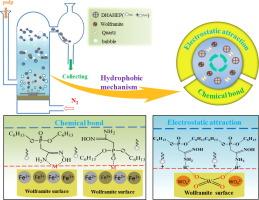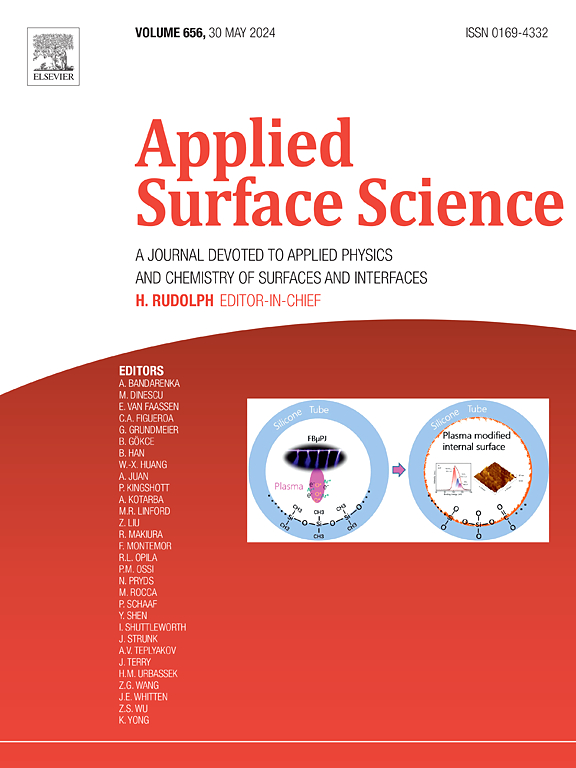A new surfactant dihexyl (2-amino-2-(hydroxyimino)ethyl) phosphonate as a collector to flotation separation of wolframite against quartz
IF 6.3
2区 材料科学
Q2 CHEMISTRY, PHYSICAL
引用次数: 0
Abstract
Herein, a novel surfactant dihexyl (2-amino-2-(hydroxyimino)ethyl) phosphonate (DHAHEP) was synthesized by combining phosphonate and amidoxime groups in the same molecule, and used as a flotation collector for quartz vein-type wolframite. The Micro-flotation results showed that DHAHEP has excellent collection performance for wolframite, at pH 2 ∼ 4.5, the flotation recovery of DHAHEP for wolframite was over 90 %, while that for quartz was less than 60 %. The wolframite-quartz artificial mixed ores experiments demonstrated that at pH ∼ 4 and DHAHEP concentration of 8 × 10-5 mol·L-1, the flotation recovery of wolframite was 64.5 % and the grade was 48.9 %. Zeta potential and contact angle experiments elucidated that DHAHEP anchored on the wolframite surface mainly in the form of cations, increasing the hydrophobicity of the surface and thus separating the wolframite from quartz by flotation. FTIR, XPS, and DFT calculation further revealed that DHAHEP had an obvious flotation separation effect on quartz vein-type wolframite, it was mainly electrostatically adsorbed on the WO42- sites on the wolframite surface in the form of cations, and also captured wolframite by forming chemical bonds with the Fe active sites through the phosphoryl and amidoxime groups in its molecular structure.

一种新型表面活性剂(2-氨基-2-(羟基亚氨基)乙基)膦酸二己酯作为捕收剂浮选分离黑钨矿和石英
本文通过在同一分子中结合膦酸基和脒肟基,合成了一种新型表面活性剂(2-氨基-2-(羟基亚氨基)乙基)膦酸二己酯(DHAHEP),并将其用作石英脉型黑钨矿的浮选捕收剂。微浮选结果表明,DHAHEP 对黑钨矿具有优异的捕收性能,在 pH 2 ∼ 4.5 的条件下,DHAHEP 对黑钨矿的浮选回收率超过 90%,而对石英的浮选回收率低于 60%。黑钨矿-石英人工混合矿石实验表明,当 pH 值∼ 4 和 DHAHEP 浓度为 8 × 10-5 mol-L-1 时,黑钨矿的浮选回收率为 64.5%,品位为 48.9%。Zeta电位和接触角实验表明,DHAHEP主要以阳离子的形式锚定在黑钨矿表面,增加了表面的疏水性,从而通过浮选将黑钨矿从石英中分离出来。傅立叶变换红外光谱、XPS和DFT计算进一步表明,DHAHEP对石英脉型黑钨矿具有明显的浮选分离效果,它主要以阳离子的形式静电吸附在黑钨矿表面的WO42-位点上,同时通过其分子结构中的磷酰和脒肟基团与铁的活性位点形成化学键而捕获黑钨矿。
本文章由计算机程序翻译,如有差异,请以英文原文为准。
求助全文
约1分钟内获得全文
求助全文
来源期刊

Applied Surface Science
工程技术-材料科学:膜
CiteScore
12.50
自引率
7.50%
发文量
3393
审稿时长
67 days
期刊介绍:
Applied Surface Science covers topics contributing to a better understanding of surfaces, interfaces, nanostructures and their applications. The journal is concerned with scientific research on the atomic and molecular level of material properties determined with specific surface analytical techniques and/or computational methods, as well as the processing of such structures.
 求助内容:
求助内容: 应助结果提醒方式:
应助结果提醒方式:


